10 - A brief conclusion
Published online by Cambridge University Press: 03 May 2011
Summary
In Chapter 1, we suggested that the end result of the study of the microfoundations of macroeconomics would look different to different kinds of economists. The objectives of a microeconomist might be met by presenting a reasonably detailed structure in which various well-understood market failures would lie at the heart of macroeconomic conundrums like inflation and unemployment. To a macroeconomist, a successful reconciliation of micro and macro might entail a return to Marshallian price theory, or a well worked out statement of individual behavior in a non-optimizing framework. To a historian of thought, it would be a reasonable sort of endeavor if it could explain how the neo-Walrasian and Keynesian research programs grew, grew apart, and what features of each made them appear incompatible.
After our efforts in Part II, however, matters become somewhat clearer. Stripping the idea of general equlibrium theory down to models of interrelated and systemic interaction, there is almost an embarrassment of riches in the sense that it is no longer the case that a general equilibrium framework itself determines uniquely the kind of macroeconomics one can do. Gone are the days when general equilibrium theory required only numeraire money, no production, fulfilled expectations, Walras' Law, tatonnement price adjustments, reversible time, futures markets for all commodities, an equilibrium defined by market clearing, etc. To argue that general equilibrium theory provides no theory of unemployment because the theory assumes Walras' Law may have been a useful way to indulge oneself in the late 1930s, but it is irrelevant to general equilibrium theory today.
- Type
- Chapter
- Information
- MicrofoundationsThe Compatibility of Microeconomics and Macroeconomics, pp. 157 - 162Publisher: Cambridge University PressPrint publication year: 1979



